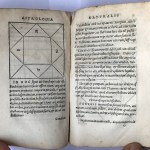DE INDAGINE, Johannes. Introductiones apotelesmaticae elegantes, in chyromantiam, physiognomiam, astrologiam naturalem, complexiones hominum, naturas planetarum, cum periaxiomatibus de faciebus signorum, et canonibus de aegritudinibus, nusquam ferè simili tractata compendio.
Frakfurt am Main, Cyriacus Jacob, 1551.
£ 1,850
8vo, ff. 143, A-R8 S6. Italic letter, a little Roman. Large woodcut vignette with portrait of the author on t-p, historiated initials and numerous half- and full-page illustrations. Printer’s device on recto of last leaf, ms. mathematical calculations on verso. Copiously annotated and underlined by an early hand, mostly in the chiromancy section. First three initial leaves particularly worn and soiled, especially the t-p: corners and margins damaged with paper loss, central area with wormholes affecting the vignette, loss of text and marginalia. Occasional dampstaining and spotting. In contemporary limp wallet vellum, rather worn, lower corner of front cover torn apart, hole on rear cover, visible ties, ink title to spine, little wormed. A complete, interesting copy, beautifully illustrated, despite the poor condition of the t-p.
Rare illustrated Renaissance work on astrology, physiognomy and chiromancy. Chiromancy is the art of reading character and divining the future by interpretation of the lines and undulations on the palm of the hands. Mediaeval chiromancy was pressed into service by the witch-hunters. After a period of disrepute, it flourished again in the Renaissance. Johannes Indagine (ca. 1467 – 1537, also known as Johannes Rosenbach, or von Hagen), a Carthusian monk, was perhaps the most highly regarded German chiromancer of the sixteenth century and “an extremely learned man in many fields” (cf. Gettings, p. 177). This work was banned by the Inquisition, having been placed on the Index Librorum Prohibitorum under the decree of Pope Paul IV in 1559 (see, Thorndike 1923). “Possevin holds that this was on account of the author’s astrology, but the other astrologers are all in Class 2. Indagine was placed in Class 1 for his letter to O. Brunfels, published at the end of the volume, which had undoubtedly come to attention in Rome: for this, the author was considered a Lutheran” (cf. Reusch). Illustrated throughout with woodcuts by several artists, showing physiognomic heads and mythological designs representing the signs of the Zodiac, as well as chiromantic hands and numerous astrological diagrams. The work had a great effect on the study of chiromancy and is quoted down to our own day.












